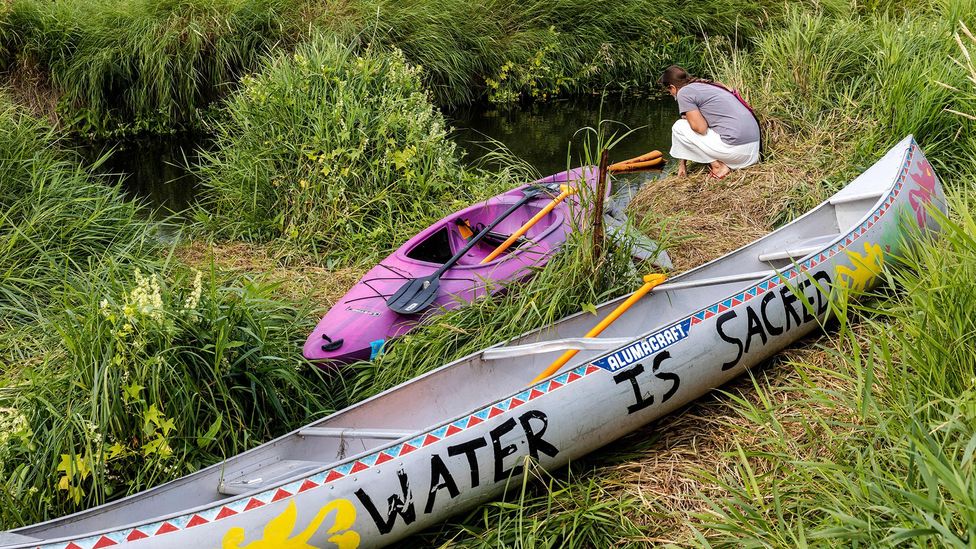Climate scientists are working with indigenous tribes
Climate scientists are working with indigenous tribes BBC.com


Native peoples have long collected environmental data. Now scientists are cataloguing these observations and learning how they’re affecting indigenous communities globally.
When the warm nights used to come each summer, Frank Ettawageshik would spend most of his time outdoors, sleeping outside, right on the ground. Today, he balks at the thought.
“I was 35 or so before I ever saw a tick,” says the 74-year-old executive director of the United Tribes of Michigan, a Native American advocacy group. Now in northern Michigan, he says, “there’s ticks all over the place”.
Ettawageshik belongs to the Anishinaabe people, whose members are from the Great Lakes. His own Tribal Nation is the Little Traverse Bay Bands of Odawa Indians, who have lived in the northwestern shores of Michigan’s lower peninsula for centuries. Besides the spread of ticks, a phenomenon exacerbated by rising temperatures, they’ve witnessed the struggling populations of whitefish in nearby Lake Michigan and the gradual changes in harvests from the sugar maple tree, whose name in Odawa is “niinatig” — meaning “our tree”. Research suggesting warmer temperatures might force sugar maples out of Michigan add to Ettawageshik’s concerns. “Our tree is going to be moving away from us,” he says.
Ettawageshik’s tribe has observed many changes to their ancestral lands over hundreds of years, but Ettawageshik says human-caused climate change is different. “It’s happening at a pace that we don’t normally see.”
For many people, climate science brings to mind satellite observations, temperature records or the analysis of ice cores. But there’s plenty more data besides that. Indigenous communities that have long lived close to the land — and have traditionally depended on deep knowledge of their environments to survive — often hold their own records and recollections. These can include extraordinary details about alterations in weather patterns, changes in vegetation or unfamiliar behavior of animals that have emerged under their watch.

The Anishinaabe tribal community have been collaborating with scientists to document struggling populations of whitefish in Lake Michigan (Credit: Getty Images)
Today, anthropologists and climate researchers working for Western institutions are increasingly turning to indigenous people to ask what they have observed about the world around them. In the process, these scientists are learning that indigenous communities have been cataloguing, in their own way and often in their own language, data at a hyper-local level — insights that Westernised climate science might miss — and also how that change is affecting people.
“I believe in Native science — that it’s real science,” says Richard Stoffle, an anthropologist at the University of Arizona, lead author on a 2023 paper that includes numerous observations from Anishinaabe people belonging to three tribes in the Upper Great Lakes. The anonymous interviews, conducted in 1998 and 2014, feature comments on a wide range of environmental changes witnessed by Anishinaabe people over the decades: hotter summers, drier springs, mushrooms emerging at unusual times of the year, or plants that don’t yield as much fruit or sap as they used to.
SDGs, Targets, and Indicators
1. Which SDGs are addressed or connected to the issues highlighted in the article?
- SDG 13: Climate Action
- SDG 15: Life on Land
- SDG 16: Peace, Justice, and Strong Institutions
2. What specific targets under those SDGs can be identified based on the article’s content?
- SDG 13.1: Strengthen resilience and adaptive capacity to climate-related hazards and natural disasters
- SDG 13.2: Integrate climate change measures into national policies, strategies, and planning
- SDG 15.1: Ensure the conservation, restoration, and sustainable use of terrestrial and inland freshwater ecosystems and their services
- SDG 15.5: Take urgent and significant action to reduce the degradation of natural habitats
- SDG 16.7: Ensure responsive, inclusive, participatory, and representative decision-making at all levels
3. Are there any indicators mentioned or implied in the article that can be used to measure progress towards the identified targets?
- Observations of alterations in weather patterns
- Changes in vegetation
- Unfamiliar behavior of animals
- Coastal erosion
- Changes in fruit abundance, size, and quality
4. Table: SDGs, Targets, and Indicators
| SDGs | Targets | Indicators |
|---|---|---|
| SDG 13: Climate Action | 13.1 Strengthen resilience and adaptive capacity to climate-related hazards and natural disasters 13.2 Integrate climate change measures into national policies, strategies, and planning |
– Observations of alterations in weather patterns – Changes in vegetation – Unfamiliar behavior of animals |
| SDG 15: Life on Land | 15.1 Ensure the conservation, restoration, and sustainable use of terrestrial and inland freshwater ecosystems and their services 15.5 Take urgent and significant action to reduce the degradation of natural habitats |
– Changes in vegetation – Unfamiliar behavior of animals – Coastal erosion |
| SDG 16: Peace, Justice, and Strong Institutions | 16.7 Ensure responsive, inclusive, participatory, and representative decision-making at all levels | N/A |
Behold! This splendid article springs forth from the wellspring of knowledge, shaped by a wondrous proprietary AI technology that delved into a vast ocean of data, illuminating the path towards the Sustainable Development Goals. Remember that all rights are reserved by SDG Investors LLC, empowering us to champion progress together.
Source: bbc.com

Join us, as fellow seekers of change, on a transformative journey at https://sdgtalks.ai/welcome, where you can become a member and actively contribute to shaping a brighter future.







